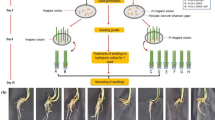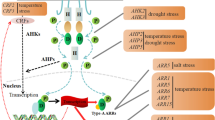Abstract
Decapitation or treatment with naphthylphthalamic acid (NPA) ndash; an inhibitor of IAA transport ndash; or a synthetic cytokinin N-(2-chloro-4-pyridyl)-N-phenylurea (CPPU) caused a decrease in rooting of pea cuttings. However the mode of action of the above treatments was different. Decapitation resulted in a decrease of indole-3-acetic acid (IAA) and a simultaneous increase in cytokinin content at the base of the cuttings. NPA decreased IAA even more, but did not influence cytokinins. CPPU alone or in combination with amino-ethoxy-vinylglycine (AVG) ndash; an ethylene biosynthesis inhibitor ndash; increased IAA at the rooting zone, but CPPU was transported from apex to the base of the cuttings where it inhibited rooting. NAA, applied alone after decapitation, stimulated rooting, probably partly by being an auxin, and partly by inhibiting the accumulation of cytokinins at the base of the cuttings. Treatment with AVG neither influenced rooting nor auxin or cytokinin content. Therefore, ethylene production does not seem to be one of the main factors involved in the reduced rooting after the various treatments.
Similar content being viewed by others

References
Bangerth F (1994) Response of cytokinin concentration in the xylem exudate of bean (Phaseolus vulgaris L.) plants to decapitation and auxin treatment and relationship to apical dominance. Planta 194: 439–442
Bartell G and Eliasson L (1992) Cytokinin effects on root growth and possible interactions with ethylene and indole-3-acetic acid. Physiol Plant 84: 255–261
Blakesley D, Weston GD and Elliott MC (1991) Endogenous levels of indole-3-acetic acid and abscisic acid during the rooting of Cotinus coggygria cuttings taken at different times of the year. Plant Growth Reg 10: 1–12
Bohner J and Bangerth F (1988) Cell number, cell size and hormone levels in semiisogenic mutants of Lycopersicon pimpinellifolium differing in fruit size. Physiol Plant 72: 316–320
Bollmark M and Eliasson L (1986) Effects of exogenous cytokinins on root formation in pea cuttings. Physiol Plant 68: 662–666
Bollmark M, Kubat B and Eliasson L (1988) Variation in endogenous cytokinin content during adventitious root formation in pea cuttings. J Plant Physiol 132: 262–265
Brunner H (1978) Influence of various growth substances and metabolic inhibitors on root regenerating tissue of Phaseolus vulgaris L. Changes in the content of growth substances and in peroxidase and IAA-oxidase activities. Zeitschrift für Pflanzenphysiologie 88: 13–23
Davis TD (1988) Effect of shoot growth retardants and inhibitors. In: Davis TD, Haissig BE and Sankhla N (eds) Adventitious root formation in cuttings Vol 2 pp 174–184
Eliasson L and Areblad K (1984) Auxin effects on rooting in pea cuttings. Physiol Plant 61: 293–297
Eriksen EN (1973) Root formation in pea cuttings. I. Effects of decapitation and disbudding at different developmental stages. Physiol Plant 28: 503–506
Eriksen EN (1974) Root formation in pea cuttings. III. The influence of cytokinins at different developmental stages. Physiol Plant 30: 163–167
Fernqvist L (1966) Studies on factors in adventitious root formation. Lantbruskhogskolans Annaler 32: 109–244
Gaither DH (1975) Sites of auxin action. Regulation of geotropism, growth and ethylene production by inhibitors of auxin transport. Plant Physiol 56: 404–409
Geneve RL and Heuser CW (1983) The relationship between ethylene and auxin on adventitious root initiation in cuttings of Vigna radiata (L.) R Wilcz. J Amer Soc Hortic Sci 108: 330–333
Haissig BE (1972) Meristematic activity during adventitious root primordium development. Influences of endogenous auxin and applied gibberellic acid. Plant Physiol 49: 886–892
Jarvis BC (1986) Endogenous control of adventitious rooting in non-woody cuttings. In: Jackson MB (ed) New root formation in plant cuttings, pp 191–222. The Netherlands: Martinus Nijhoff Publishers Dordrech
Katekar GF and Geissler AF (1977) Auxin transport inhibitors. Plant Physiol 60: 826–829
Katsumi M, Chiba Y and Fukuyama M (1969) The roles of the cotyledons and auxin in the adventitious root formation of hypocotyl cuttings of light grown cucumber seedlings. Physiol Plant 22; 993–1000
Krishnamoorthy HN (1970) Promotion of rooting in mung bean hypocotyl cuttings with ethrel, an ethylene releasing compound. Plant Cell Physiol 11: 979–982
Leopold AC and Lam SL (1961) Polar transport of three auxins. In: Klein RM (ed) Plant Growth Regulation, pp 411–418. IA: Iowa State University Press Ames
Li CJ and Bangerth F (1992) The possible role of cytokinins, ethylene and indole acetic acid in apical dominance. In: Karssen CM, van Loon LC and Vreugdenhill D (eds) Progress in Plant Regulation, pp 431–436. Dordrecht: Kluwer Academic Publ.
Li CJ, Guevara E, Herrera J and Bangerth F (1995) Effect of apex excision and replacement by 1-naphthylacetic acid on cytokinin concentration and apical dominance in pea plants. Physiol Plant 94: 465–469
Mudge KW and Swanson BT (1978) Effect of ethephon, indole-butyric acid and treatment solution pH on rooting and ethylene levels within mung bean cuttings. Plant Physiol 61: 271–273
Nordstom A-C and Eliasson L (1984) Regulation of root formation by auxin-ethylene interaction in pea stem cuttings. Physiol Plant 61: 298–302
Nordstrom A-C and Eliasson L (1991) Levels of endogenous indole-3-acetic acid and indole-3-acetylaspartic acid during adventitious root formation in pea cuttings. Physiol Plant 82: 599–605
Nordstrom A-C and Eliasson L (1993) Interaction of ethylene with indole-3-acetic acid in regulation of rooting in pea cuttings. Plant Growth Regulation 12: 83–90
Robbins JA, Kays SJ and Dirr MA (1983) Enhanced rooting of wounded mung bean cuttings by wounding and ethephon. J Amer Soc Hort Sci 108: 325–329
Weigel U, Horn W and Hock B (1984) Endogenous auxin levels in terminal stem cuttings of Chrysanthemum morifolium during adventitious rooting. Physiol Plant 61: 422–428
Author information
Authors and Affiliations
Rights and permissions
About this article
Cite this article
Koukourikou-Petridou, M., Bangerth, F. Effect of changing the endogenous concentration of auxins and cytokinins and the production of ethylene in pea stem cuttings on adventitious root formation. Plant Growth Regulation 22, 101–108 (1997). https://doi.org/10.1023/A:1005833311839
Issue Date:
DOI: https://doi.org/10.1023/A:1005833311839



